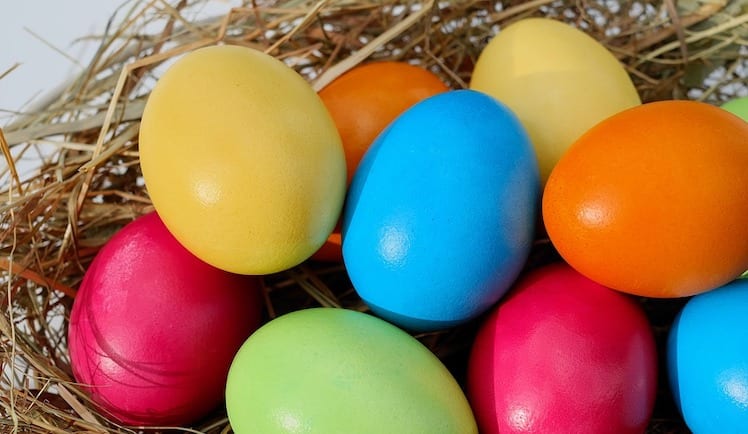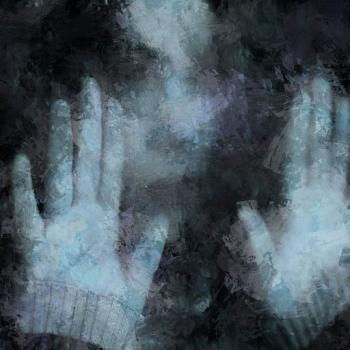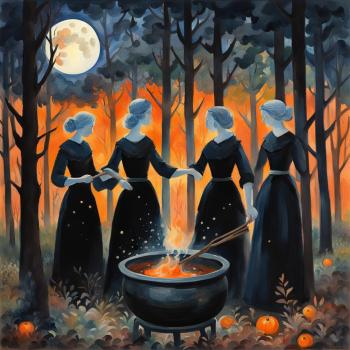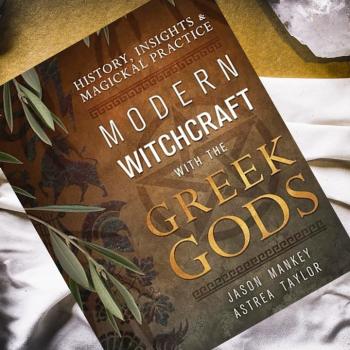If you have listened my family’s podcast, 3 Pagans and a Cat, then you know Michigan has transformed into the Ice Planet Hoth. Temperatures are hovering in the low teens, wind chills are in the negative numbers and inches of fluffy white snow are filling our lawns, sidewalks and highways. The cold and gray makes me more inclined to decorate a Yule tree and dress my altar in poinsettia and mistletoe.

The idea that Spring is “just around the corner” seems remote. The last thing I want to do is think about finding tulips and daffodils or how to get strawberry seeds to germinate. I’d rather curl up with a cup of hot tea and read a good book. However, the Spring Equinox will arrive in a couple of weeks. Rather than wallow in how cold my feet seem to be, brightening my home in preparation for Ostara might work a bit of magick, draw the sunny weather closer. And what better way is there to get in the Ostara mood then to decorate some eggs!
Coloring eggs in beautiful shades of green, yellow, red, and blue in celebration of Spring takes me back to fond memories of childhood decorating Easter eggs with my siblings. Honestly, I never understood how the activity could be part of a religious celebration for a man from the ancient Middle East. As a Witch, decorated eggs are a symbol of regeneration, rejuvenation, new life, change and transformation. Celebrating the time of renewal and new life with colored eggs makes sense if you think about how nature works out reproduction for birds, fish, insects and reptiles (and some of their eggs are pretty in their own right).
Cultures around the world have celebrated the concepts of fertility and rejuvenation for thousands of years. The Iranian New year, Nowruz (also known as New Day or the Persian New Year) falls on the Spring Equinox and decorated eggs are part of their celebration. Ukranians have a tradition of decorated eggs known as “pysanka” (utilizing wax to create intricate shapes before the egg is colored) which might date back to the worship of Dazhboh from pre-Christian times.
Germanic cultures could have included colored eggs in their Spring celebrations as well. Modern tradition connects a Germanic/English goddess known as Eostre with decorated eggs and rabbits in connection to Spring. Eostre’s name is said to be the origin of the word “Easter” in connection to the Christian holiday. However, there is little to no evidence of this goddess beyond the work of a monk known as the Venerable Bede. Even so, unverified personal gnosis has given life to Eostre’s mythology as a fertility or Spring/Dawn goddess.

The most common story of Eostre and her connection to eggs and rabbits goes like this:
One day, as the goddess Eostre walked through a forest she came across an injured bird. Seeing the bird so near to death grieved the goddess’ heart, so she decided to save the bird. Eostre transformed the injured bird into a healthy young rabbit. When the bird awoke she found herself healed and changed from her former state but not through a complete transformation. The former bird discovered that even as a rabbit she could lay eggs. Happy to have another chance at life, the rabbit decorated the eggs she lay and gave them to Eostre as an offering of thanks.
Regardless of the origin of decorated eggs for Spring celebrations the activity is one which can bring joy and life into a household. Whether done with family, a group of children, or a gathering of friends decorating eggs for Ostara is a way to reconnect with each other and await the awakening of the land to Spring.
Decorating Eggs with Fruits and Vegetables
(Adapted from Berry Chatty at Fruit Bouquets)
Red beets = Pink to red
Red onion skins = Pale purple to red
Red cabbage = Blue
Spinach = Green
Cherries and strawberries = Deep red
Purple grape juice (use as is) = Lavender
Raspberries or blackberries = Pink/purple
Blueberries = Blue
Yellow or green apple peels = Yellow/green
Carrots = Yellow/orange
Natural dyes will take longer to work than store bought kits (think PAAS with the tablets and vinegar/water. These are synthetic dyes so they work faster). Leave the eggs to soak overnight for better color.
Making Natural Dyes
Step 1: Chop or mash your fruits and veggies until you have enough to fill about 4 cups.
Step 2: Boil them in 4 cups of water and 2 tablespoons of white vinegar.
Step 3: Leave it to simmer for about 30 minutes and strain out any leftover fruit or vegetable bits.
Step 4: Place each color in a separate bowl and leave your hard boiled or hollowed out eggs to soak overnight.














